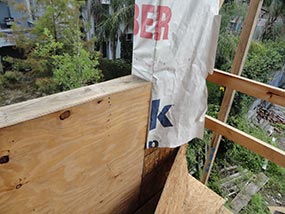Welcome Post
Posted on: November 25, 2013 | Posted in:
Uncategorized

The photo shows a not uncommon problem with the manner in which a water-resistant barrier, in this case, Tyvek, is being installed on a residential project. Unfortunately, oftentimes those installing materials are not taking the time to insure the installation is being performed properly, and frequently unnecessary damage results. An owner should have his general contractor get the Tyvek installation instructions and Code report (numbers printed on the wrap itself so there can be no mistake about where to go get the required information) and the other available manufacturers literature for the proper use of their products, and make sure they are followed. Generally the manufacturers, especially of a good product like Tyvek, has all the materials you need to get the installation done right.
The low wall in the photo has to be handled like a window, except flashed like a window from both sides.
In essence, the building wrap is the dividing line between inside and outside, between wet and dry. So you have to make sure that water can’t get behind it, or around the ends, corners, laps, seams, or through penetrations, etc. Otherwise, you and your building are going to get wet.
 The photo shows a not uncommon problem with the manner in which a water-resistant barrier, in this case, Tyvek, is being installed on a residential project. Unfortunately, oftentimes those installing materials are not taking the time to insure the installation is being performed properly, and frequently unnecessary damage results. An owner should have his general contractor get the Tyvek installation instructions and Code report (numbers printed on the wrap itself so there can be no mistake about where to go get the required information) and the other available manufacturers literature for the proper use of their products, and make sure they are followed. Generally the manufacturers, especially of a good product like Tyvek, has all the materials you need to get the installation done right.
The photo shows a not uncommon problem with the manner in which a water-resistant barrier, in this case, Tyvek, is being installed on a residential project. Unfortunately, oftentimes those installing materials are not taking the time to insure the installation is being performed properly, and frequently unnecessary damage results. An owner should have his general contractor get the Tyvek installation instructions and Code report (numbers printed on the wrap itself so there can be no mistake about where to go get the required information) and the other available manufacturers literature for the proper use of their products, and make sure they are followed. Generally the manufacturers, especially of a good product like Tyvek, has all the materials you need to get the installation done right.